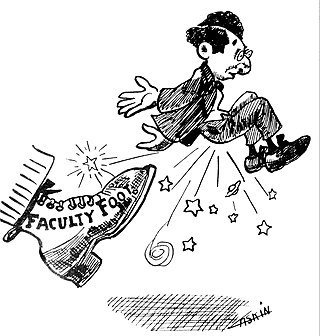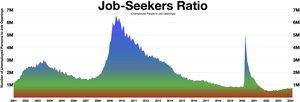
Remote work is the practice of working from one's home or another space rather than from an office.
In organizational behavior and industrial and organizational psychology, organizational commitment is an individual's psychological attachment to the organization. Organizational scientists have also developed many nuanced definitions of organizational commitment, and numerous scales to measure them. Exemplary of this work is Meyer and Allen's model of commitment, which was developed to integrate numerous definitions of commitment that had been proliferated in the literature. Meyer and Allen's model has also been critiqued because the model is not consistent with empirical findings. It may also not be fully applicable in domains such as customer behavior. There has also been debate surrounding what Meyers and Allen's model was trying to achieve.
Employment is a relationship between two parties regulating the provision of paid labour services. Usually based on a contract, one party, the employer, which might be a corporation, a not-for-profit organization, a co-operative, or any other entity, pays the other, the employee, in return for carrying out assigned work. Employees work in return for wages, which can be paid on the basis of an hourly rate, by piecework or an annual salary, depending on the type of work an employee does, the prevailing conditions of the sector and the bargaining power between the parties. Employees in some sectors may receive gratuities, bonus payments or stock options. In some types of employment, employees may receive benefits in addition to payment. Benefits may include health insurance, housing, and disability insurance. Employment is typically governed by employment laws, organisation or legal contracts.
A layoff or downsizing is the temporary suspension or permanent termination of employment of an employee or, more commonly, a group of employees for business reasons, such as personnel management or downsizing an organization. Originally, layoff referred exclusively to a temporary interruption in work, or employment but this has evolved to a permanent elimination of a position in both British and US English, requiring the addition of "temporary" to specify the original meaning of the word. A layoff is not to be confused with wrongful termination.

Termination of employment or separation of employment is an employee's departure from a job and the end of an employee's duration with an employer. Termination may be voluntary on the employee's part (resignation), or it may be at the hands of the employer, often in the form of dismissal (firing) or a layoff. Dismissal or firing is usually thought to be the employee's fault, whereas a layoff is generally done for business reasons outside the employee's performance.
Absenteeism is a habitual pattern of absence from a duty or obligation without good reason. Generally, absenteeism refers to unplanned absences. Absenteeism has been viewed as an indicator of poor individual performance, as well as a breach of an implicit contract between employee and employer. It is seen as a management problem, and framed in economic or quasi-economic terms. More recent scholarship seeks to understand absenteeism as an indicator of psychological, medical, or social adjustment to work.
Personnel economics has been defined as "the application of economic and mathematical approaches and econometric and statistical methods to traditional questions in human resources management". It is an area of applied micro labor economics, but there are a few key distinctions. One distinction, not always clearcut, is that studies in personnel economics deal with the personnel management within firms, and thus internal labor markets, while those in labor economics deal with labor markets as such, whether external or internal. In addition, personnel economics deals with issues related to both managerial-supervisory and non-supervisory workers.
Workplace bullying is a persistent pattern of mistreatment from others in the workplace that causes either physical or emotional harm. It can include such tactics as verbal, nonverbal, psychological, and physical abuse, as well as humiliation. This type of workplace aggression is particularly difficult because, unlike the typical school bully, workplace bullies often operate within the established rules and policies of their organization and their society. In the majority of cases, bullying in the workplace is reported as having been done by someone who has authority over the victim. However, bullies can also be peers, and subordinates. When subordinates participate in bullying this phenomenon is known as upwards bullying. The least visible segment of workplace bullying involves upwards bullying where bullying tactics are manipulated and applied against “the boss,” usually for strategically designed outcomes.

Employee engagement is a fundamental concept in the effort to understand and describe, both qualitatively and quantitatively, the nature of the relationship between an organization and its employees. An "engaged employee" is defined as one who is fully absorbed by and enthusiastic about their work and so takes positive action to further the organization's reputation and interests. An engaged employee has a positive attitude towards the organization and its values. In contrast, a disengaged employee may range from someone doing the bare minimum at work, up to an employee who is actively damaging the company's work output and reputation.
Workplace wellness, also known as corporate wellbeing outside the United States, is a broad term used to describe activities, programs, and/or organizational policies designed to support healthy behavior in the workplace. This often involves health education, medical screenings, weight management programs, and onsite fitness programs or facilities. It can also include flex-time for exercise, providing onsite kitchen and eating areas, offering healthy food options in vending machines, holding "walk and talk" meetings, and offering financial and other incentives for participation.
Customer attrition, also known as customer churn, customer turnover, or customer defection, is the loss of clients or customers.
A workplace is a location where someone works, for their employer or themselves, a place of employment. Such a place can range from a home office to a large office building or factory. For industrialized societies, the workplace is one of the most important social spaces other than the home, constituting "a central concept for several entities: the worker and [their] family, the employing organization, the customers of the organization, and the society as a whole". The development of new communication technologies has led to the development of the virtual workplace and remote work.

Occupational stress is psychological stress related to one's job. Occupational stress refers to a chronic condition. Occupational stress can be managed by understanding what the stressful conditions at work are and taking steps to remediate those conditions. Occupational stress can occur when workers do not feel supported by supervisors or coworkers, feel as if they have little control over the work they perform, or find that their efforts on the job are incommensurate with the job's rewards. Occupational stress is a concern for both employees and employers because stressful job conditions are related to employees' emotional well-being, physical health, and job performance. The World Health Organization and the International Labour Organization conducted a study. The results showed that exposure to long working hours, operates through increased psycho-social occupational stress. It is the occupational risk factor with the largest attributable burden of disease, according to these official estimates causing an estimated 745,000 workers to die from ischemic heart disease and stroke events in 2016.
A dead-end job is a job where there is little or no chance of career development and advancement into a better position. If an individual requires further education to progress within their firm that is difficult to obtain for any reason, this can result in the occupation being classified as a dead-end position. Based on human resources and career strategist Toni Howard Lowe, some individuals who have worked for the same company for several years may not be privy to the signs that they are currently employed in a dead-end job.
Employee retention is the ability of an organization to retain its employees and ensure sustainability. Employee retention can be represented by a simple statistic. Employee retention is also the strategies employers use to try to retain the employees in their workforce.
Counterproductive work behavior (CWB) is employee's behavior that goes against the legitimate interests of an organization. This behavior can harm the organization, other people within it, and other people and organizations outside it, including employers, other employees, suppliers, clients, patients and citizens. It has been proposed that a person-by-environment interaction (the relationship between a person's psychological and physical capacities and the demands placed on those capacities by the person's social and physical environment.) can be utilized to explain a variety of counterproductive behaviors. For instance, an employee who is high on trait anger is more likely to respond to a stressful incident at work with CWB.
Compensation and benefits (C&B) is a sub-discipline of human resources, focused on employee compensation and benefits policy-making. While compensation and benefits are tangible, there are intangible rewards such as recognition, work-life and development. Combined, these are referred to as total rewards. The term "compensation and benefits" refers to the discipline as well as the rewards themselves.
A “toxic workplace” is a colloquial metaphor used to describe a place of work, usually an office environment, that is marked by significant personal conflicts between those who work there. A toxic work environment has a negative impact on an organization's productivity and viability. This type of environment can be detrimental to both the effectiveness of the workplace and the well-being of its employees.
A job attitude is a set of evaluations of one's job that constitute one's feelings toward, beliefs about, and attachment to one's job. Overall job attitude can be conceptualized in two ways. Either as affective job satisfaction that constitutes a general or global subjective feeling about a job, or as a composite of objective cognitive assessments of specific job facets, such as pay, conditions, opportunities and other aspects of a particular job. Employees evaluate their advancement opportunities by observing their job, their occupation, and their employer.
Employee morale or workspace morale is the morale of employees in workspace environment. It is proven to have a direct effect on productivity.






